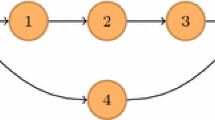Abstract
Baker and Smith [J. Scheduling, 6, 7–16, 2003] introduced a new model of scheduling in which there are two or more distinct families of jobs pursuing different objectives. Their contributions include two polynomial-time dynamic programming recursions, respectively, for the single machine scheduling with two families of jobs to minimize a positive combination of total weighted completion time, or maximum lateness, of the first family of jobs and maximum lateness of the second family of jobs. Unfortunately, these dynamic programming recursions are incorrect. In this paper, we solve the same problems by an O(n1 n2(n1 + n2)) time algorithm.
Similar content being viewed by others
References
Baker, K. R. and J. C. Smith, “A multiple-criterion model for machine scheduling,” Journal of Scheduling, 6, 7–16, (2003).
Author information
Authors and Affiliations
Corresponding author
Additional information
Project supported by NNSFC (Grant 10371112) and NSFHN (Grant 0411011200)
Rights and permissions
About this article
Cite this article
Yuan, J.J., Shang, W.P. & Feng, Q. A note on the scheduling with two families of jobs. J Sched 8, 537–542 (2005). https://doi.org/10.1007/s10951-005-4997-z
Issue Date:
DOI: https://doi.org/10.1007/s10951-005-4997-z




